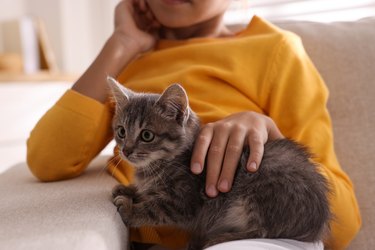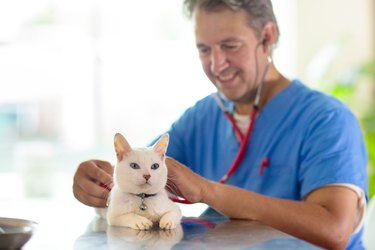If your cat suffers a wound or has issues with their eyes, you should consult with your veterinarian before doing any home treatment. Veterinary care may be needed, and you'll need advice. If your vet says it is ok, you might also be able to keep the wound clean at home with a basic sterile saline solution or salt water.

Video of the Day
Are these wounds on my cat superficial or serious?
Small scratches or cuts that do not go through all layers of the skin can be treated with a cleaning solution of warm water and salt. This is a much safer option than hydrogen peroxide or harsh disinfectants. These types of wounds do not need stitches, but they do need to be kept clean and monitored.
Video of the Day
More serious feline wounds are cuts or lacerations that go through all layers of the skin. Wounds in high-motion areas of the cat, like where their legs connect to the body, can also be more serious. High-motion areas cause the skin edges to repeatedly separate, so stitches are needed to keep the skin edges close enough together to heal.
These types of cat wounds need veterinary treatment. It is likely that your veterinarian will clean the wound and prescribe antibiotics to ward off infection. The wound will be closed with stitches if need be and may require a drain tube.
Puncture wounds in cats
Any type of puncture wound on your cat needs to be treated by your veterinarian. Puncture wounds can be caused from a sharp object or an animal bite, and they tend to get infected easily. Your veterinarian will clean the wound, apply stitches if needed, and usually prescribe antibiotics.

Feline eye injuries
If your cat has eye discharge, a swollen eye, or is keeping their eye partially or fully closed, it is likely from an eye injury. If both eyes are affected, it is likely from an infection or other illness, such as environmental allergies or other irritants, like cigarette smoke. It's best in either case to seek veterinary care.
Squinting the eyelids partially or fully is a sign of pain and can indicate a foreign body in the eye, like a piece of plant matter under the third eyelid. Squinting can also mean the cat has a corneal scratch, a corneal ulcer, or an eye infection. All of these issues require prompt medical attention. While your veterinarian may instruct you to use a warm, moist compress or saline solution to clean the cat's eye, it's unlikely you'll be repeatedly flushing an eye with injuries or infection. Cats don't tolerate this well.
Homemade saline solution recipe and use for cats
Cat wounds should be flushed with a normal saline or isotonic saline. Avoid using hypotonic (less sodium) or hypertonic (more sodium) saline solutions, as they can cause swelling, irritation, or drying. Normal, sterile saline solutions (sodium chloride) are available at drug stores and are labeled "first aid saline wound wash." Avoid nasal or sinus spray saline.
To make a simple saline solution at home, combine 1 quart of warm water with 1 tablespoon of salt. Mix well until the salt dissolves completely. Allow the solution to cool to room temperature before use.

Home remedies for cat wounds
Always check with your veterinarian before providing any sort of home remedies or home treatment for your dogs and cats. Many home remedies that are on the internet are not safe or effective. If your cat requires wound care at home, your veterinarian will instruct you on how often to do this and what to use. This could be antibiotic eye drops, ointment, or a saline solution.
If your cat requires wound care at home, your veterinarian will instruct you on how often to do this and what to use. This could be antibiotic eye drops, ointment, or a saline solution. You will also want to keep your cat indoors if possible to prevent further contamination of the wound. If you can't keep your cat indoors, you'll have to be particularly diligent in keeping the wound clean and checking the wound at least twice a day (morning and evening). In warm weather when flies are out, keep an eye out for maggots because flies lay eggs in wounds.
Before cleaning your cat's eye, make sure they are gently restrained. You might wrap a towel around them to prevent sudden movement or injury to yourself. Gently and slowly wipe around your cat's affected eye with a gauze pad or cotton ball soaked in the saline solution. Make sure your cat's eye is closed. Wipe away from the nose to remove any discharge or debris near the eye and off eyelashes if the eyelids are stuck together.
Do not wipe your cat's eyeball, as this can cause injury. If you need to clean the actual eye itself, insert a syringe into the saline solution and draw up some of the liquid. Gently open your cat's eyelids. Flush the eyeball with the eye drops.
The bottom line
Home care, such as a saline solution, can offer your cat some relief. However, you should always consult your DVM before you do anything at home, and especially if your cat has a wound or eye irritation. If your cat develops new symptoms or worsening of symptoms, contact your veterinarian immediately. Deep cuts or infections will need medical attention.